|
Workshops & Lectures
Through workshops and lectures, four international artists, living
in Berlin, invite the public to think about the non-human by means
of selected artistic, performative and scientific methods. Mushrooms,
mosses, lichens and bacterial processes, as well as Berlin wetlands,
play a central role.

Alanna Lynch | Gut feelings
June 18, 2017
As part of her ongoing research Alanna Lynch has been growing
the microorganisms that produce kombucha tea. Through the process
of fermentation this symbiotic colony of bacteria and yeasts (SCOBY)
produces a cellulose material that is slimy and smells strongly
while wet and can be dried and used as a textile. However, Lynch's
interest in working with this life form goes beyond the material
properties. Throughout this research Lynch has been actively consuming
the microorganisms by drinking the tea. Given that about half of
the cells in the human body are bacterial cells and acknowledging
the microbiome-gut-brain axis whereby bacteria in the gut have been
shown to effect the mind, how people think, feel and even behave,
bacteria can be seen as radical in the potential it has to challenge
categories such as subject/object, mind/body and human/non-human.
(More information)
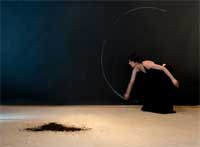
Margherita
Pevere | Anatomy of an inter-connected system
15 July, 2017
Starting point of this seminar is the artist’s research at
the junction of visual arts, theoretical inquiry and investigation
of biological processes. The seminar will focus on the discourses
regarding human-nature relationship in the frame of today’s
environmental crisis and how artistic practices involving living
organisms and technology can innovatively contribute to the debate.
How can artists problematise the complex interconnection between
humans and the biosphere in a hyper-technological era? With what
kind of aesthetic and ethical implications? The project aims at
engaging the audience in a performative discussion with a visual
outcome.
(More information)

Theresa Schubert | The forestal psyche
25 & 26 August, 2017
The
lecture and workshop are based on the artist's long-term artistic
research project on living organisms as an artistic material and
medium. For this project, Schubert dedicates herself to the potential
of slime moulds, mosses and lichens from the forests around Berlin.
Slime moulds are the largest known single-celled organisms and live
from decaying matter on the forest floor. Certain mosses and lichens
are natural remedies as well as indicators of good air quality.
Apart from a scientific approach, forests have always been places
of myths, legends and fantasies. How can you combine imagination
and biotechnology in an artistic project? Can one "demystify"
hard science by interpreting it creatively?
(More
information)
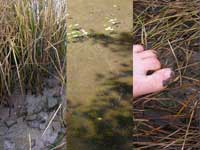
Sarah Hermanutz | ill-at-ease seep
28 October 2017
In
her lecture the artist Sarah Hermanutz will discuss the relationship
between humans and wetlands, which is the focus in her long-term
artistic research. Wetlands are one of the most biologically diverse
and important ecosystems for life on earth, but within the past
century mankind has destroyed over 50% of them. The artist explores
our historical and contemporary relationship with these environments,
including the tropes and prejudices that have marginalised them
and justified their continued draining and destruction. Engagement
with the uncomfortable sensory and aesthetic experience of wetlands
is proposed as essential to reintegrating humans within these ecological
communities.
(More
information)
Presentation of Nonhuman Agents
14 September, 2017, 7-11 PM
15-17 September, 2017, 1-4PM
Results from the first three workshops as well as our upcoming Autumn
programme were presented at Art Laboratory Berlin during the Berlin
Art Week (in cooperation with the Berlin Network of Independent
Project Spaces and Initiatives and the Berlin Senate Department
for Culture and Europe)
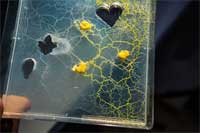
2-day-Workshop
Heather
Barnett + plan b (Sophia New & Daniel Belasco Rogers) | Swarm
| Cell | City
23
& 24 September, 2017
This 2-day workshop is a participatory experiment on art, performance
and biology that precedes the exhibition Nonhuman Networks.
The project invites the participants to view the city of Berlin
by the nonhuman perspectives of the intelligent single-cell organism
Physarum polycephalum and GPS tracking.
(More
information)
Exhibition
Nonhuman Networks
Heather Barnett|
Saša Spačal
with Mirjan Švagelj & Anil Podgornik
Opening: 29 September, 2017 8PM | Exhibition runs: 30
September - 26 November, 2017
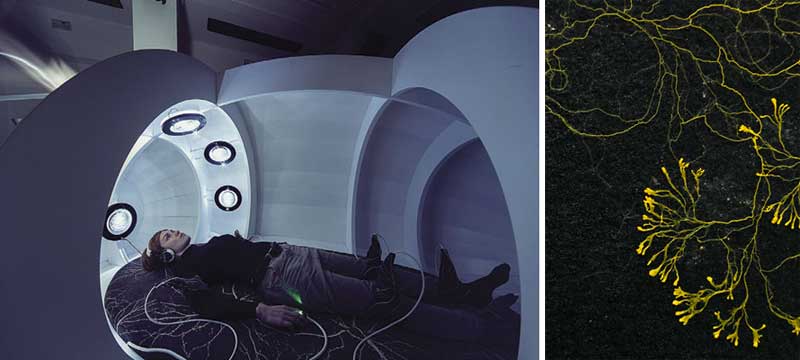 Left:
Saša
Spačal,
Mirjan Švagelj and Anil Podgornik, Myconnect, Installation,
2014, Damjan Švarc / Kapelica gallery photo archive;
Left:
Saša
Spačal,
Mirjan Švagelj and Anil Podgornik, Myconnect, Installation,
2014, Damjan Švarc / Kapelica gallery photo archive;
right Heather Barnett, The Physarum Experiments Study No. 022,
Film still, 2016
Nonhuman
Networks presents an aesthetics of new forms of communication
between human and nonhuman actors. How does the world's largest
single celled creature function as a computer? Can we tap into the
so-called 'Internet of trees'? Performative works act as enablers
for the audience to engage in non-linguistic forms of awareness
and contact with several deceptively simple life forms.
Saša
Spačal,
Mirjan Švagelj and Anil Podgornik combine art,
biology and cybernetics to create a platform for inter species communication.
In Myconnect the nervous system of a person and fungal mycelium
are plugged into a biofeedback loop. By entering the capsule a person
is equipped with a heartbeat sensor, headphones and vibrational
motors that are placed on various parts of the body. The heartbeat
of a person sets the system in motion. The signal travels through
the mycelium where it is modulated in real-time. The modulated signal
is transferred back to the human body via sound, light and tactile
sensory impulses. The overwhelming stimuli that affect the nervous
system cause an alteration of the heartbeat. A new loop begins and
the circle is closed. A symbiosis of signals begins.
Heather
Barnett is an artist, researcher and educator working with natural
phenomena and biological design, often in collaboration with scientists,
artists, participants and organisms. Utilising living materials
and imaging technologies, her practice explores how we observe,
represent and understand the world around us. Projects include microbial
portraiture, systems modelling, and an ongoing 'collaboration' with
an intelligent slime mould, Physarum polycephalum. As one
of the world's largest single-celled organisms, the slime mould
possesses the ability to solve spatial problems and learn from interactions
with its environment. The exhibition builds upon Barnett's unique
combination of interdisciplinary research and participatory practice.
(More information)
Interdisciplinary
Conference
Nonhuman Agents in Art, Culture and Theory
24-26 November, 2017
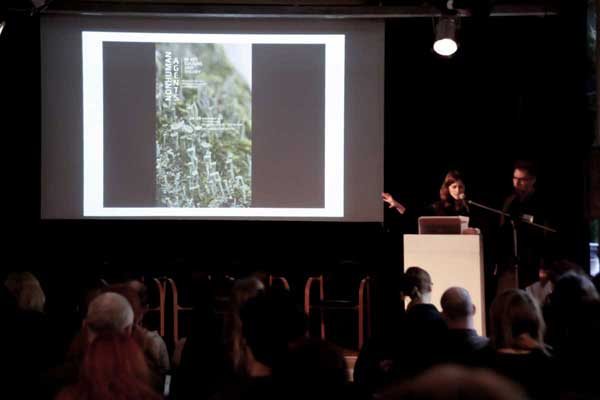
Finally, an interdisciplinary conference brings together international
artists, scholars, and natural scientists from different disciplines
to discuss artistic, philosophical, ethical and scientific approaches
to nonhuman agents. The previous positions from the Nonhuman
Subjectivities series will also be taken into account.
Cooperation
partners: European Media Studies, University Potsdam
(More
information)
With
the generous support of:



Media
partner:

Cooperation
partner:

|
|






 Left:
Saša
Spačal,
Mirjan Švagelj and Anil Podgornik, Myconnect, Installation,
2014, Damjan Švarc / Kapelica gallery photo archive;
Left:
Saša
Spačal,
Mirjan Švagelj and Anil Podgornik, Myconnect, Installation,
2014, Damjan Švarc / Kapelica gallery photo archive; 



